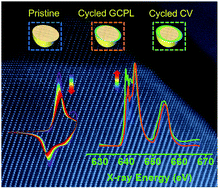Influence of synthesis conditions on the surface passivation and electrochemical behavior of layered cathode materials†
Abstract
Understanding the relationship between materials synthesis and electrochemical behaviors should provide valuable knowledge to further the advancement of lithium-ion batteries. In this work, layered cathode materials {e.g., LiNi0.4Mn0.4Co0.18Ti0.02O2 (NMCs)} were prepared under three different annealing conditions, i.e., 900 °C for 6 hours, 8 hours, and 12 hours, respectively. The resulting materials exhibit equivalent crystal structures and morphologies yet likely different surface chemical environments. These materials show distinctively different resistances against the surface passivation/reconstruction (reduction of the transition metals in the layered structure to form rock-salt and/or spinel phases) during electrochemical cycling (2.0–4.7 V vs. Li+/Li). In general, the materials annealed for longer durations exhibited lower tendencies to form the surface passivation layer. Furthermore, the surface passivation became less severe when the electrode materials were cycled under mild conditions, such as slow constant current charging–discharging as opposed to cyclic voltammetry. The present study correlates the synthetic conditions with the surface instability and the electrochemical performance in cathode materials, and provides new insights into improving synthetic protocols for battery materials.


 Please wait while we load your content...
Please wait while we load your content...